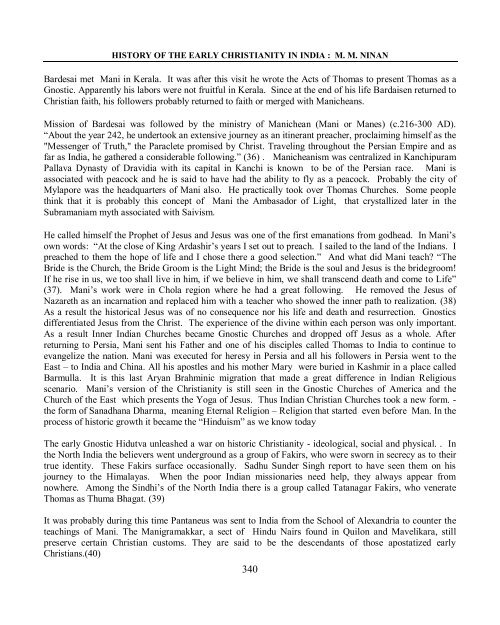Acts of Apostle Thomas
You also want an ePaper? Increase the reach of your titles
YUMPU automatically turns print PDFs into web optimized ePapers that Google loves.
HISTORY OF THE EARLY CHRISTIANITY IN INDIA : M. M. NINAN<br />
Bardesai met Mani in Kerala. It was after this visit he wrote the <strong>Acts</strong> <strong>of</strong> <strong>Thomas</strong> to present <strong>Thomas</strong> as a<br />
Gnostic. Apparently his labors were not fruitful in Kerala. Since at the end <strong>of</strong> his life Bardaisen returned to<br />
Christian faith, his followers probably returned to faith or merged with Manicheans.<br />
Mission <strong>of</strong> Bardesai was followed by the ministry <strong>of</strong> Manichean (Mani or Manes) (c.216-300 AD).<br />
“About the year 242, he undertook an extensive journey as an itinerant preacher, proclaiming himself as the<br />
"Messenger <strong>of</strong> Truth," the Paraclete promised by Christ. Traveling throughout the Persian Empire and as<br />
far as India, he gathered a considerable following.” (36) . Manicheanism was centralized in Kanchipuram<br />
Pallava Dynasty <strong>of</strong> Dravidia with its capital in Kanchi is known to be <strong>of</strong> the Persian race. Mani is<br />
associated with peacock and he is said to have had the ability to fly as a peacock. Probably the city <strong>of</strong><br />
Mylapore was the headquarters <strong>of</strong> Mani also. He practically took over <strong>Thomas</strong> Churches. Some people<br />
think that it is probably this concept <strong>of</strong> Mani the Ambasador <strong>of</strong> Light, that crystallized later in the<br />
Subramaniam myth associated with Saivism.<br />
He called himself the Prophet <strong>of</strong> Jesus and Jesus was one <strong>of</strong> the first emanations from godhead. In Mani’s<br />
own words: “At the close <strong>of</strong> King Ardashir’s years I set out to preach. I sailed to the land <strong>of</strong> the Indians. I<br />
preached to them the hope <strong>of</strong> life and I chose there a good selection.” And what did Mani teach? “The<br />
Bride is the Church, the Bride Groom is the Light Mind; the Bride is the soul and Jesus is the bridegroom!<br />
If he rise in us, we too shall live in him, if we believe in him, we shall transcend death and come to Life”<br />
(37). Mani’s work were in Chola region where he had a great following. He removed the Jesus <strong>of</strong><br />
Nazareth as an incarnation and replaced him with a teacher who showed the inner path to realization. (38)<br />
As a result the historical Jesus was <strong>of</strong> no consequence nor his life and death and resurrection. Gnostics<br />
differentiated Jesus from the Christ. The experience <strong>of</strong> the divine within each person was only important.<br />
As a result Inner Indian Churches became Gnostic Churches and dropped <strong>of</strong>f Jesus as a whole. After<br />
returning to Persia, Mani sent his Father and one <strong>of</strong> his disciples called <strong>Thomas</strong> to India to continue to<br />
evangelize the nation. Mani was executed for heresy in Persia and all his followers in Persia went to the<br />
East – to India and China. All his apostles and his mother Mary were buried in Kashmir in a place called<br />
Barmulla. It is this last Aryan Brahminic migration that made a great difference in Indian Religious<br />
scenario. Mani’s version <strong>of</strong> the Christianity is still seen in the Gnostic Churches <strong>of</strong> America and the<br />
Church <strong>of</strong> the East which presents the Yoga <strong>of</strong> Jesus. Thus Indian Christian Churches took a new form. -<br />
the form <strong>of</strong> Sanadhana Dharma, meaning Eternal Religion – Religion that started even before Man. In the<br />
process <strong>of</strong> historic growth it became the “Hinduism” as we know today<br />
The early Gnostic Hidutva unleashed a war on historic Christianity - ideological, social and physical. . In<br />
the North India the believers went underground as a group <strong>of</strong> Fakirs, who were sworn in secrecy as to their<br />
true identity. These Fakirs surface occasionally. Sadhu Sunder Singh report to have seen them on his<br />
journey to the Himalayas. When the poor Indian missionaries need help, they always appear from<br />
nowhere. Among the Sindhi’s <strong>of</strong> the North India there is a group called Tatanagar Fakirs, who venerate<br />
<strong>Thomas</strong> as Thuma Bhagat. (39)<br />
It was probably during this time Pantaneus was sent to India from the School <strong>of</strong> Alexandria to counter the<br />
teachings <strong>of</strong> Mani. The Manigramakkar, a sect <strong>of</strong> Hindu Nairs found in Quilon and Mavelikara, still<br />
preserve certain Christian customs. They are said to be the descendants <strong>of</strong> those apostatized early<br />
Christians.(40)<br />
340


















